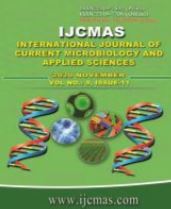


 National Academy of Agricultural Sciences (NAAS)
National Academy of Agricultural Sciences (NAAS)

|
PRINT ISSN : 2319-7692
Online ISSN : 2319-7706 Issues : 12 per year Publisher : Excellent Publishers Email : editorijcmas@gmail.com / submit@ijcmas.com Editor-in-chief: Dr.M.Prakash Index Copernicus ICV 2018: 95.39 NAAS RATING 2020: 5.38 |
The human population on the planet is estimated to reach 9 billion by 2050; this requires significant increase of food production to meet the demands. Intensified farming systems have been identified as a viable means to increase grain production. Crop production inputs include carbon investment in the form of energy, for the manufacture and use of farm machinery, synthetic fertilizers, crop protection chemicals such as herbicides, insecticides and fungicides, groundwater irrigation and the direct use of fuel in farm operations. Such production technology operations in the agriculture sector contribute to Greenhouse Gas (GHG) emissions. On-farm cultivation operations also result in the loss of soil organic matter (SOM), hence another source of carbon (C) emission. Changes in cropland use and management practices influence direct and indirect energy consumption and emission of GHGs. The latest GHG inventory for India shows that the contribution of agriculture to country’s total emissions is18 per cent, of which about 21per cent is related to nitrous oxide (N2O) emissions from agricultural soils and18 per cent to rice production. Green revolution technologies in diverse agro-climatic zones of Northern India have led to the overexploitation of the natural resources, especially groundwater. Moreover, GHG driven changing climate is adding to the environmental woes. Under such complex situations, firstly, it becomes very important to register the effect of each management activity on the overall C footprint of crop production. Secondly, as the areal distribution of crops, groundwater extraction and fertilizer consumption has changed invariably within different agro climatic zones of Northern India over time, thus, it is important to do spatio-temporal analysis of the change in C use efficiency, net C returns and C cost per unit of production in different crops. With increase in production level of crops, mainly sugarcane and cereal crops the amount of their residues, subjected to field burning, also grew from 15.9% in 2008-09 to 24% in 2016-17. Sustainability indices, based on inputs and outputs, helped identify crops with lower carbon footprint or more carbon efficient crops. Such spectacular gains in food grain production were mainly because of increased yields resulting from improved crop varieties combined with greater use of fertilizers, irrigation, plant protection chemicals, and other technologies associated with the ‘Green Revolution’. However, these gains in food grain production have come at a cost to the environment. During the last 40 years (1970 to 2010), emission of greenhouse gases (GHGs) from the agriculture sector has increased by 35 percent, from 4.2 to 5.7 Gt CO eq yr-1 (Gt or Giga tonne = 1015g; CO2 = carbon dioxide). The increase has been greater during the decade 2000-2010, when agricultural emissions increased by 1.1 percent annually. Thus, there is a need for sustainable intensification of production systems for maintaining high yields without compromising the environmental integrity.
 |
 |
 |
 |
 |